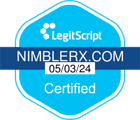


How to Successfully Launch a Medication Therapy Management Program
Running a successful independent pharmacy in 2025 and beyond will require expanding the role of your pharmacy beyond just dispensing medications. Your patients likely frequent your pharmacy more than they would a doctor’s office or lab. In fact, patients visit their local pharmacist up to 2x as often as they visit other healthcare professionals.
One of the best ways to capitalize on patients' desire to see more from pharmacies is to start offering more services and programs like Medication Therapy Management (MTM).
Launching a MTM program can significantly enhance patient outcomes and boost the success of your independent pharmacy. Keep reading on for a step-by-step guide to help you establish a successful MTM program.
Gauge Interest and Prime Your Patients with Educational Materials
Before fully investing in MTM, it’s a good idea to gauge the interest your patients may have in participating. Work on educating patients who might most benefit from MTM on what exactly it is in practice and survey them to determine true interest levels.
Once you’ve determined if MTM is right for your practice, start informing patients about the availability and benefits of MTM services. Identify individuals who may benefit the most, such as those taking multiple medications, managing chronic conditions, or recently discharged from the hospital. Offering incentives or flexible consultation options, including virtual sessions, can encourage participation.
Train and Involve Your Pharmacy Team
Ensure that all staff members are well-trained in MTM services. Encourage them to promote these services during patient interactions.
Pharmacy students and interns can assist by reviewing medication histories and preparing for MTM sessions, fostering a collaborative environment that enhances the patient experience.
Conduct Comprehensive Medication Reviews
During MTM sessions, perform thorough medication reviews to identify potential side effects, drug interactions, or duplications. Utilize both open-ended questions (e.g., "What do you take for your high cholesterol?") and closed-ended questions (e.g., "Do you take medication for your high cholesterol?") to gather detailed information.
This approach helps in tailoring interventions that optimize therapeutic outcomes.
Simplify Communication and Emphasize Medication Adherence
Use clear, jargon-free language when discussing medications with patients. Provide easy-to-read handouts and employ visual aids to enhance understanding. This clarity empowers patients to manage their medications effectively.
Educate patients on the importance of their medication regimens. Understanding their beliefs and motivations, and practicing patient-centered medicine, will allow you to tailor adherence strategies effectively. Recommend tools like mobile app reminders, like Nimble, or pill organizers to support consistent medication use.
Keep Detailed Records and Collaborate with Other Healthcare Providers
Maintain detailed records of each MTM patient's concerns and any interventions made. Schedule follow-up appointments to monitor progress and address any emerging issues, ensuring continuity of care. Establish open collaboration with physicians and other healthcare professionals involved in your patients' care. This collaboration ensures a cohesive approach to medication management, enhancing patient safety and treatment efficacy.
Implementing these strategies can lead to a successful MTM program that not only improves patient health outcomes but also positions your pharmacy as a vital component of the healthcare team!



















.jpg)





















.jpg)

















.jpg)


























.jpg)
.jpg)
.jpg)













